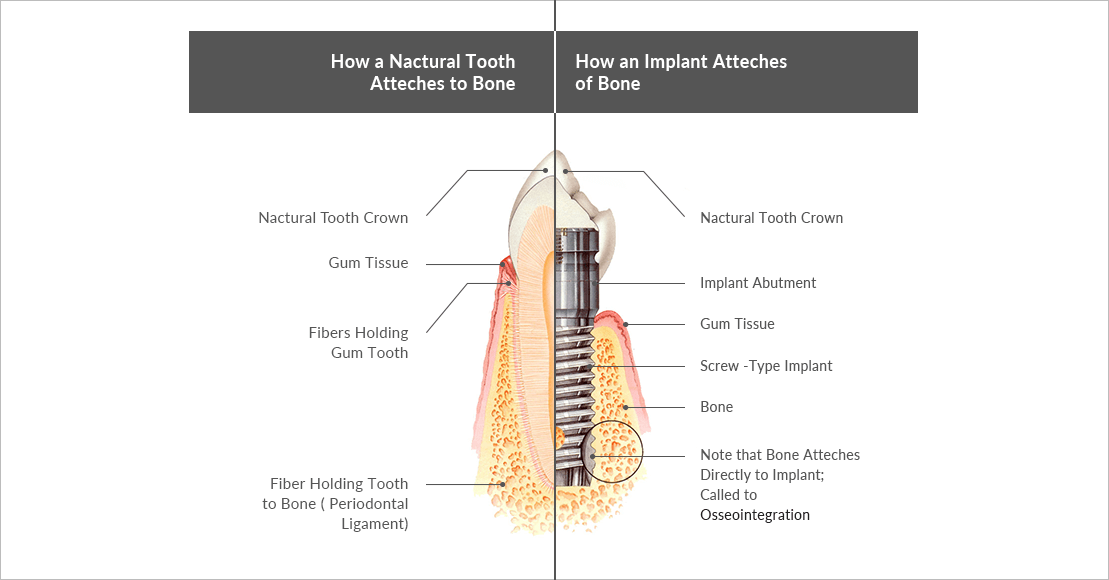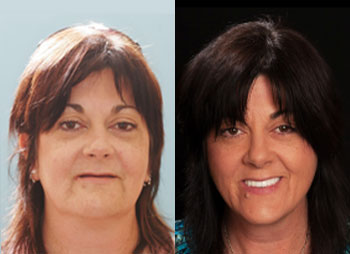
Serving all of Southern California
Call today! (949) 955-3366
Providing Dental Implants to Newport Coast, and all of Orange County
Dental implants are an option available to replace missing teeth. An implant is a titanium rod that is fused to the jawbone in order to function as the tooth root, which will support a dental crown. To replace multiple missing teeth, a few implants can hold a bridge, dentures, or partial dentures. The replacement teeth will look and function like natural teeth and can improve a person’s ability to smile, speak, and chew properly. Before and after implant dentistry in Orange County, CAAlthough dentures and bridges that are supported by the natural tooth root can remedy many of the problems associated with missing teeth, they cannot prevent future bone loss the way dental implants can. This is why dental implants are often recommended to most patients who need to replace missing teeth.
Few people know that when a tooth is lost, the lack of stimulation to the supporting jawbone causes a decrease in bone volume and density over time (atrophy). As the jawbone shrinks, the overlying muscle and skin collapse along with it, which can make a person appear older than their actual age.


Dental implants prevent the wasting away of the jawbone by serving as an anchor for the new teeth. During the recovery process, the jawbone will literally attach itself to the implant, a process known as “osseointegration.” As chewing forces are transmitted to the bone surrounding the dental implant over time, bone growth is stimulated and bone density and volume is maintained. Since much of the bone loss from a missing tooth will occur within the first year after tooth loss, it is best to install the dental implant as soon as the tooth is extracted.
Dental Implants: Fast Facts
Best Candidates for Dental Implants
Dental implants are a solution for patients of all ages, with the exception of growing children.
The best candidates for dental implants have:
Although ideal candidates are those who have good oral and general health and have adequate bone mass, dental implants may be used on patients who do not meet these criteria. Implants have been successfully placed in those who have existing medical conditions, such as high blood pressure and diabetes. Those who have lost their teeth and have experienced bone loss as a result of periodontal disease or decay have also experienced good results with dental implants. Certain procedures, such as ridge augmentation or a sinus lift, may be necessary to improve jaw deformities or to ensure that the implants have enough bone to attach to. During a consultation at Art of Dentistry Institute, your health history and the oral and dental structures will be assessed to determine if you are a candidate for the procedure
Types of Dental Implants
1. Endosteal Implants
The most common type of implants, these are surgically implanted directly into the jawbone.
2. Subperiosteal Implants
Subperiosteal implants are placed under the gum but above the jawbone. These implants are for those who have a shallow jawbone but cannot or do not want to undergo a procedure to rebuild it.
Dental Implants Procedure Process
1. Replacing a single tooth
One dental implant with a crown cemented or screwed to it will replace a single tooth.
2. Replacing several teeth
Fixed bridges will replace several teeth using few to several implants. Adjacent natural teeth may need to be shaped or cut down to receive the bridged crowns.
3. Replacing all teeth
Implants can support a full bridge or full dentures. The exact number of dental implants required to provide adequate, long-lasting support depends on many things, including the amount and quality of existing bone, the bite, and other anatomic factors.

Emil Hawary, DDS, FAACD, FAGD Your award winning dentist!
